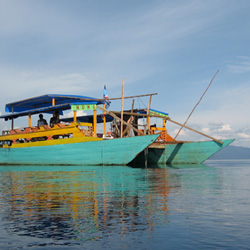Life in Earth’s primordial sea was starved for sulfate

Research vessel on Lake Matano, Indonesia. Sean Crowe, University of British Columbia.
The findings paint a new portrait of our planet’s early biosphere and primitive marine life. Organisms require sulfur as a nutrient, and it plays a central role in regulating atmospheric chemistry and global climate.
“Our findings are a fraction of previous estimates, and thousands of time lower than current seawater levels,” says Sean Crowe, a lead author of the study and an assistant professor in the Departments of Microbiology and Immunology, and Earth, Ocean and Atmospheric Sciences at the University of British Columbia.
“At these trace amounts, sulfate would have been poorly mixed and short-lived in the oceans—and this sulfate scarcity would have shaped the nature, activity and evolution of early life on Earth.”
UBC, University of Southern Denmark, CalTech, University of Minnesota Duluth, and University of Maryland researchers used new techniques and models to calibrate fingerprints of bacterial sulfur metabolisms in Lake Matano, Indonesia — a modern lake with chemistry similar to Earth’s early oceans.
Measuring these fingerprints in rocks older than 2.5 billion years, they discovered sulfate 80 times lower than previously thought.
The more sensitive fingerprinting provides a powerful tool to search for sulfur metabolisms deep in Earth’s history or on other planets like Mars.
Findings
Previous research has suggested that Archean sulfate levels were as low as 200 micromolar— concentrations at which sulfur would still have been abundantly available to early marine life.
The new results indicate levels were likely less than 2.5 micromolar, thousands of times lower than today.
What the researchers did
Researchers used state-of-the-art mass spectrometric approaches developed at California Institute of Technology to demonstrate that microorganisms fractionate sulfur isotopes at concentrations orders of magnitude lower than previously recognized.
They found that microbial sulfur metabolisms impart large fingerprints even when sulfate is scarce.
The team used the techniques on samples from Lake Matano, Indonesia—a sulfate-poor modern analogue for the Earth’s Archean oceans.
”New measurements in these unique modern environments allow us to use numerical models to reconstruct ancient ocean chemistry with unprecedented resolution” says Sergei Katsev an Associate Professor at the Large Lakes Observatory, University of Minnesota Duluth.
Using models informed by sulfate isotope fractionation in Lake Matano, they established a new calibration for sulfate isotope fractionation that is extensible to the Earth’s oceans throughout history. The researchers then reconstructed Archean seawater sulfate concentrations using these models and an exhaustive compilation of sulfur isotope data from Archean sedimentary rocks.
Crowe initiated the research while a post-doctoral fellow with Donald Canfield at the University of Southern Denmark.
UBC Science Media Contacts
Chris Balma
Communications
UBC Science
balma@science.ubc.ca
604.822.5082
604.202.5047 (c)
Silvia Moreno-Garcia
Coordinator, Communications
silvia.moreno-garcia@science.ubc.ca
604.827.5001
Media Contact
More Information:
http://science.ubc.ca/news/816All latest news from the category: Earth Sciences
Earth Sciences (also referred to as Geosciences), which deals with basic issues surrounding our planet, plays a vital role in the area of energy and raw materials supply.
Earth Sciences comprises subjects such as geology, geography, geological informatics, paleontology, mineralogy, petrography, crystallography, geophysics, geodesy, glaciology, cartography, photogrammetry, meteorology and seismology, early-warning systems, earthquake research and polar research.
Newest articles

Properties of new materials for microchips
… can now be measured well. Reseachers of Delft University of Technology demonstrated measuring performance properties of ultrathin silicon membranes. Making ever smaller and more powerful chips requires new ultrathin…

Floating solar’s potential
… to support sustainable development by addressing climate, water, and energy goals holistically. A new study published this week in Nature Energy raises the potential for floating solar photovoltaics (FPV)…

Skyrmions move at record speeds
… a step towards the computing of the future. An international research team led by scientists from the CNRS1 has discovered that the magnetic nanobubbles2 known as skyrmions can be…




















